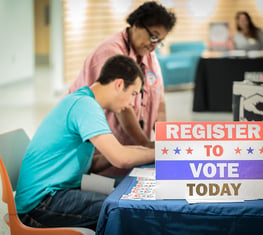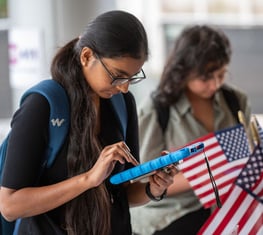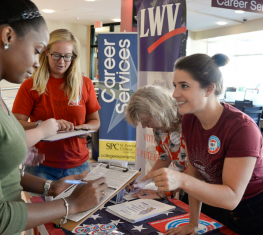This article was originally published in The Miami Student.
Recent changes to Ohio’s voting laws put the state among those with the most restrictive voting requirements in the country.
The law, House Bill 458, was passed by the Ohio legislature during a lame-duck session in December 2022 and signed by Gov. Mike DeWine in January. It went into effect on April 7.
Among the new restrictions are stricter voter ID requirements, compressed early voting times and lengthier absentee request processes. Ohio Republicans said the new measures are aimed at curbing voter fraud.
However, Kathie Brinkman, communications director for the League of Women Voters of Oxford (LWV), said there’s no evidence of voter fraud in Ohio.
“In our opinion, it’s a solution in search of a problem,” Brinkman said. “The voter ID laws and the processes we have in place have been very effective, so it’s unclear to us why this kind of law was put in place.”
Brinkman said the new measures could be politically motivated due to the lack of evidence for voter fraud.
“There’s a number of bills that will be coming up ... women’s reproductive rights is the big one,” Brinkman said. “People are circulating petitions to get that on the November ballot. And so it could be advantageous to not have as many segments of the population voting who would be in favor of that.”
Brinkman said the LWV’s biggest concern is the confusion these new laws may create among the public. For instance, people can vote online using the last four digits of their social security number but need an Ohio photo ID if voting in person. Further, registering online requires an Ohio photo ID, but registering using a paper form does not.
“There’s confusion in that a form of identification is valid in one case but not in another,” Brinkman said. “It’s a lot of information to convey to people, and it’s a lot of things to keep straight depending on who you are and where you live.”
Brinkman said another worry is how these new laws will affect voter turnout.
“When there are barriers to voting, then people have to make a decision as to whether they have the resources and the time to get past that barrier,” Brinkman said. “And some people decide that they don’t, or they haven’t allowed enough time to overcome that barrier.”
John Forren, chair and associate professor in the department of justice and community studies, said he found it confusing that the laws didn’t include a measure to request absentee ballots online. Instead, voters must print an absentee ballot request and mail it to the Ohio Board of Elections.
In previous years, a pre-addressed, pre-stamped envelope was provided. Voters must now find the address and pay for postage. The request also must be made seven days before the election, up from three days in the past. None of this can be done online.
“The technology is clearly there to do it, but, for whatever reason, the legislature decided not to make that change, even as they were making these various other changes,” Forren said.
The new laws also only allow one drop-off location in each county. If voters living in Oxford choose to drop off their absentee ballot, they must bring it to the Butler County Board of Elections in Hamilton, a 30-minute drive from Miami.
Forren said one of the most significant changes is the photo ID requirement for voting in person.
“The requirement of a photo ID will likely disproportionately affect people who are lower income, maybe don’t have access to a car, maybe are more transient in their living conditions,” Forren said. “The impact is likely to be felt most significantly by people who already have less power in our political system.”
People with disabilities are also likely to be adversely affected by the new laws. During the pandemic, many Ohio voters used curbside voting, including those who are immunocompromised. Now, only voters with physical disabilities are permitted to do so, not including people who are blind.
Stephanie Dawson, director of Student Disability Services at Miami, said poll workers are not permitted to ask voters about their disability, and voters should advocate for their needs.
“Physical disabilities exist on a spectrum. So maybe people who use mobility aids and maybe people who use wheelchairs — that's going to be a wide range of people,” Dawson said. “I would encourage people to self-advocate. Curbside voting is available for people who may be experiencing or have a physical disability.”
Another segment of the population likely to be impacted by the registration changes are out-of-state college students. These students have the right to vote in Ohio, but doing so will be more cumbersome.
If out-of-state students vote online, they can use the last four digits of their social security number. If they vote in person, they must either bring their passport or obtain an Ohio driver’s license. Obtaining an Ohio ID, however, could impact out-of-state students’ residency status and financial aid packages.
Mollie Duffy, a sophomore public administration major from Illinois, said the laws will impact how and where she votes.
“For the midterms in November, I voted in Ohio because I felt like my vote had more of an impact in Ohio than it did in Illinois,” Duffy said. “[In November], I will most likely be voting absentee [in Ohio] because my parents don’t trust me to bring my passport with me to school because they think I’ll lose it.”
Duffy, who’s also the co-founder of RedHawks Count and a civic engagement fellow within the Wilks Institute for Leadership and Service, said she worries people will be uninformed about the laws when they go to vote. Her organization raises awareness about voting in Ohio as well as other states that many Miami students come from.
“The biggest issue here is a lack of information that students have about it and how little students are talking about it,” Duffy said. “Miami, compared to other Ohio schools at least, has a lot of out-of-state students. So it’s important for us to accommodate the whole student body’s needs instead of just focusing on Ohio alone.”
Although Duffy is out of state, she encourages students to consider registering to vote as an Oxford resident because of the large impact students can have on elections.
“Oxford is the fifth most densely populated college town in the United States,” Duffy said. “If students voted in the masses in Oxford, they would have the majority say over what laws and policies are happening, who gets to be on our city council, etc.”
While the new laws can make voting harder, Forren stressed not to overstate any of the changes as the full effects are still unknown. For example, while early voting the Monday before election day was eliminated, these hours were distributed to other days.
“There’s been a lot of coverage about these sort of pullbacks on accessibility to the polls, but the right to vote is still there,” Forren said. “One real concern is that people will be discouraged from trying to vote if they just hear in general terms how it’s much harder. It’s harder, no doubt, but people should not get the message that the basic right to vote has been curtailed. People still need to go out and vote and not be discouraged by that.”
On May 4, LWV, Miami's Wilks Institute and the Howe Center are sponsoring Act Now to Save Democracy from 6 p.m. to 8 p.m. at King Library’s Howe Center. The event will help educate the public about recent changes being made to the Ohio voting laws, the threats and impacts on voting rights and the history of suppression in voting.
More information about HB 458 can be found here. Resources for voters with disabilities can be found here.
The Latest from the League
In the last two weeks, four anti-voter provisions became law in Ohio. Read our guest blog from the League of Women Voters of Ohio on these election changes and how they're keeping voters informed.
The League of Women Voters of Ohio today announced participation in a lawsuit challenging the state's U.S. congressional districts as unconstitutional.
"We are glad that, by upholding voting rights, the judge ruled on the side of the people of Pennsylvania," said the League of Women Voters of Pennsylvania (LWVPA), the lead organizational plaintiff in the lawsuit.




